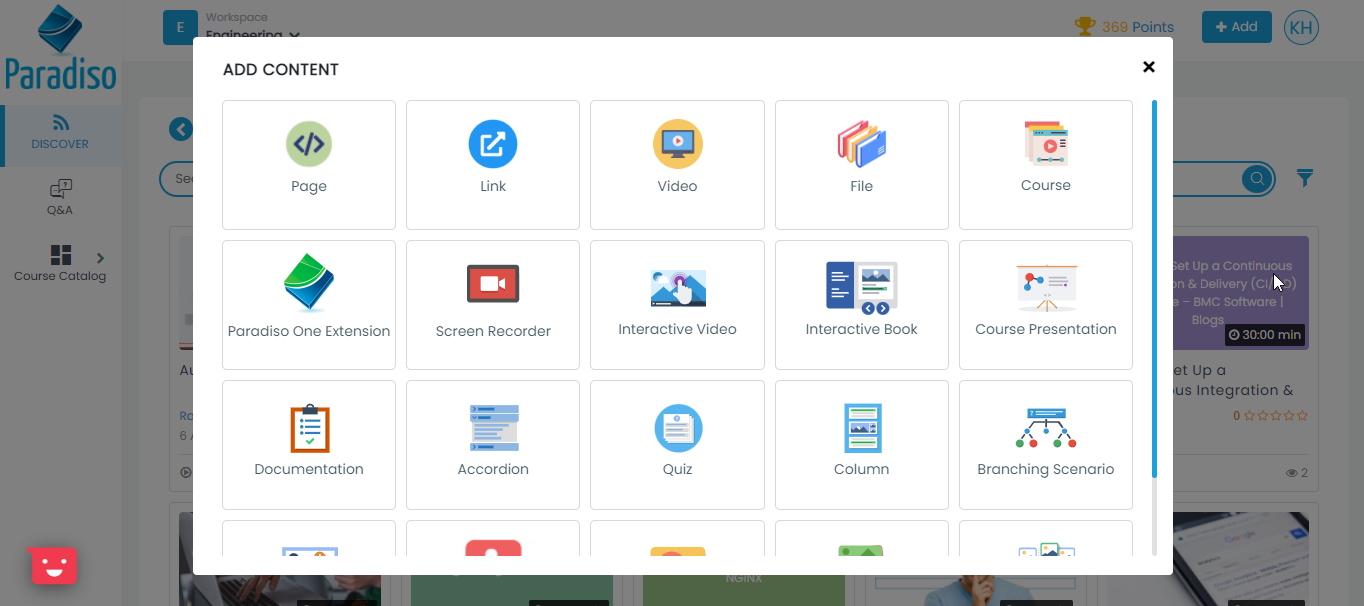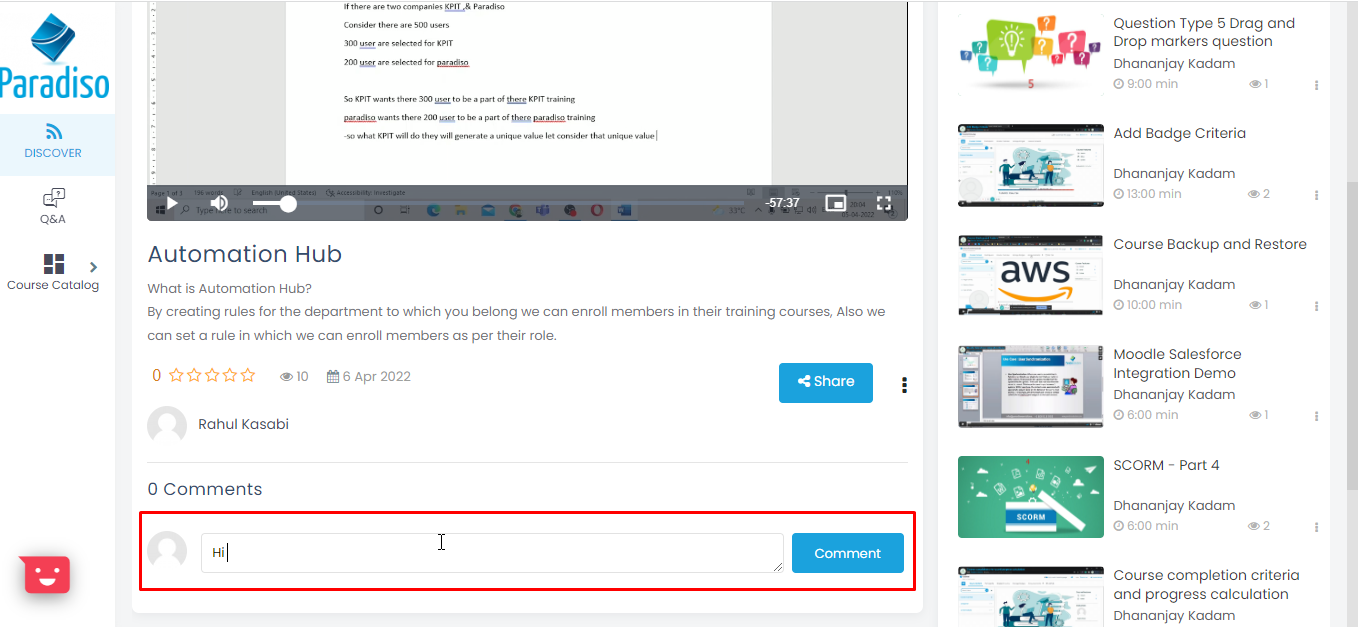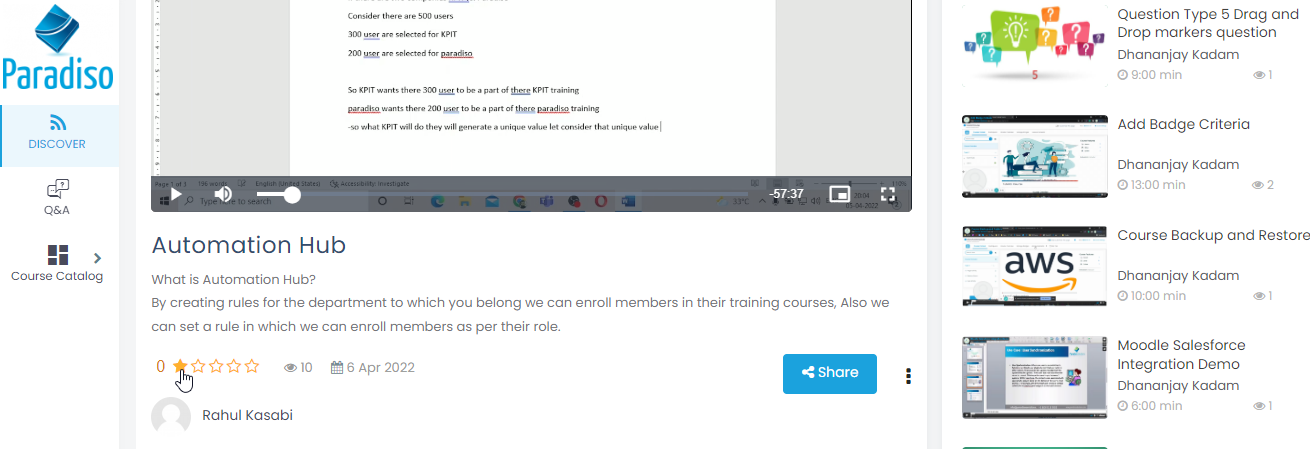About LXP
- An LXP is a learning and collaborative platform.
- An LXP is a learning platform designed to provide a personalization.
- You can subscribe to a different content type like Courses, Video, Documents, Playlist & Articles.
- LXPs are also seen as platforms that focus on providing a social and collaborative learning environment like comments, share, likes & ratings. They tend to offer social features which support peer-to-peer interactions and sharing.
LXP Features:
-
- Greater content types: LXPs go beyond traditional training delivery methods such as presentations to include articles, podcasts, links to useful websites and blogs, videos and even user-generated content. Employees not only consume content on LXPs, but they are also easily able to publish it. This encourages individuals to share knowledge with their colleagues and creates a repository for in-house knowledge.
- User-Generated Content: Subject matter experts channel their knowledge by allowing them to create and share content with their peers. Formal learning such as eLearning courses, videos, and manuals offer tremendous value, but pose the risk of being both time consuming and expensive to create. Moment-of-need microlearning in the form of user-generated content can provide low cost but high impact resources to learners through the LXP. Organization and individual learners will benefit when employees have the chance to build relationships and share knowledge with one another, facilitated by your LXP.
-
- Social media features: Like social media platforms, LXPs invite users to connect with one another, like content and post comments. These behaviors help the artificial intelligence brain of the platform better understand each user and deliver content to them that is both relevant and engaging. And, as workers share what they are learning with one another, they can also encourage others to engage with the platform and advance their own learning.
-
- Employee empowerment: LXPs are designed to offer a continuous learning experience that is controlled by the employee. That means they are not waiting around for a training to be offered or delivered to them. Instead, they can learn on their own schedules and as the need arises on the job. And because LXPs are intelligent platforms capable of offering individualized recommendations, they can also serve as a guide to help employees take the next step in career advancement.
-
- Badges and certification: LXPs often include ways for workers to earn badges or certificates through skills assessments. Because there are so many ways to learn on an LXP, these markers serve as valuable milestones for both the learner and their manager to measure and evaluate progress.
-
- Learning pathways/Playlists: The learners’ digital music libraries and streaming platforms, you’d see their content organized into themed playlists. The multimedia content in LXP (such as videos, articles, podcasts, and traditional eLearning courses) can be organized into themed playlists, including role-specific content, product-specific content, or content targeting certain learning populations. Playlists can be created by an admin or even by the learners themselves, and can be public or private based on the creator’s settings. Rock on!
- Workspaces: Workspaces are virtual communities where learners can engage with one another. Similar to forums or chat rooms, learners can hold discussions by posting comments and questions, sharing files, “liking” each other’s posts, tagging each other, and generally benefit from social learning as they observe and model on-the-job behaviors. These activities empower learners to share their knowledge with their colleagues, and to demonstrate their expertise. The social aspect of the workspaces serves as positive reinforcement for employees who help one another and contribute beneficial content to the workspace. By grouping your learners with their peers, you will help them build relationships and feel more connected to their colleagues.
-
- Recommendations: In addition to playlists, recommendations of learning assets in the LXP are another way of creating the optimal user experience often found on popular streaming services. LXP recommendations are based on the same premise; if your learner enjoyed one particular asset, they may also benefit from a recommendation for something similar. LXPs include recommendation engines, which promote a range of content based on categories such as what’s trending, related microlearning content, and even courses and workspaces that may interest the learner based on their completion history. Help your learners easily discover content that meets their needs by making use of built-in recommendations.
-
- Deep integrations: LXPs are built on their ability to integrate with almost anything. That’s part of their customer appeal over an LMS. While a Learning Management System had to have SCORM-specific content and all learning had to be practiced and recorded on the platform, LXPs are far more flexible. This flexibility extends to the content that LXPs can hold, who can write the content, the data they can collect, and where you can use the Learning Experience Platform. There’s currently a boom of integrations with workplace platforms like Slack or MS Teams. LXPs are making themselves accessible from within the spaces people are already working to limit working-learning friction.
- Data reporting: The LXPs heightened flexibility and integration capacity gives it more data to work with. This varies, but many Learning Experience Platforms can track what content was opened, by whom, for how long, and how they rated it. Through this information, you can see what type of learning, in what medium, at what time works best for each person. They can also track data from activity that didn’t happen on the LXP itself through xAPI or similar technology. So, LXPs can track external engagement campaigns, employee performance in-work, and HR data.
LXP Benefits:
- Discoverable content: One of the biggest issues with old learning content management systems is that learning content is disparate, unchecked, and undiscoverable. An LXP gives you a place to put all of this. One that’s organized and searchable. It means that learners have a far better shot at getting to the learning that can help them.
- Flexibility: LXP can be altered to fit the kind of learning that works best for your business. So, if a particular program or initiative is important, the Learning Experience Platform your learners interact with can reflect that. If internal content is important, LXPs can accommodate user-generated content. Or if you want to pull learning together to form pathways, most Learning Experience Platforms allow for that functionality too. Integration is also a major benefit of LXPs. And not just with LMSs. Wherever your business gets its work done – email, Slack, MS Teams – a good LXP can embed itself within it. This means that learning is never more than a few clicks away for your learners. Which is a boost for employee engagement.
- User-oriented: The older systems were built with administrators in mind but an LXP is all about the individual user. In an LXP, the user has far more capacity to steer their own learning. Rather than going through mandatory training modules, learners have the freedom to seek out learning content that helps their professional development and day-to-day jobs. User experience is a foundational principle for any LXP.
- Personalization: LXPs give you a lot of data to play. So, like Netflix, Spotify, or Amazon, what the user sees is curated specifically for them. Different LXPs go to different depths of personalization than others, but all tailor the learning to the user. This makes learning a lot easier and faster for learners, increasing employee engagement. This personalization is also useful for when learners are undergoing a specific process, like onboarding, offboarding, or acclimatizing to a new position. Content and learning pathways can be tailored specifically to get them the knowledge they need as efficiently as possible.
- Data-driven learning: Because of their superior integration capability, LXPs can pull together a lot of functional data. This can be internal data like search metrics, view counts, content ratings, likes, and shares. But they can also show how people responded to learning comms off the site; how learning and job performance interrelate; what’s the skills landscape – such as what skills deficiencies might arise in the near future; where, how, and when employees are learning. By integrating comfortably with your business’s entire digital ecosystem, an LXP can give you a bird’s eye view of learning’s ROI and overall impact.
LXPs are very likely to hike up a business’s learning engagement levels. LXPs are also more accessible. They can accommodate and categories different forms of content so learners can pick the medium and style they want. Most are also mobile friendly. Given that 57% of online content is consumed on mobile devices and tablets, this can potentially double the opportunities for learning experiences in your organization.
Along with these few other benefits are –
- LXP has ability to connect to and integrate with other (existing) systems and tools implemented at companies and institutions, distinguishes these platforms, from learning ecosystems of the past.
- LXPs take conventional training models a step further, by acting as curator, repository and dispenser of learning content and learning records, along with serving the backbone of corporate learning technology.
- Compliments learning with additional capabilities, such as broader skill development and creating highly customized, dynamic career/learning pathways
- LXPs can use data from expanded learning interactions to establish a fuller understanding of the impact between learning and on-job performance
- A more flexible and dynamic learning ecosystem largely learner-driven.
- Learners can add new content and take decisions on what to consume and how.
- Learner-generated content is also common on these platforms.
How to access LXP:
- Step 1: Click on “Discover” for the new feature in our LMS “LXP”
- Step 2: Search Content
- Step 3: Share content with colleagues
- Step 4: Other colleagues will receive an email after sharing video or any content.
- Step 5: Click on Add button to add content.
- Step 6: Give comment on the added content.
- Step 7: Give rating to the added content.
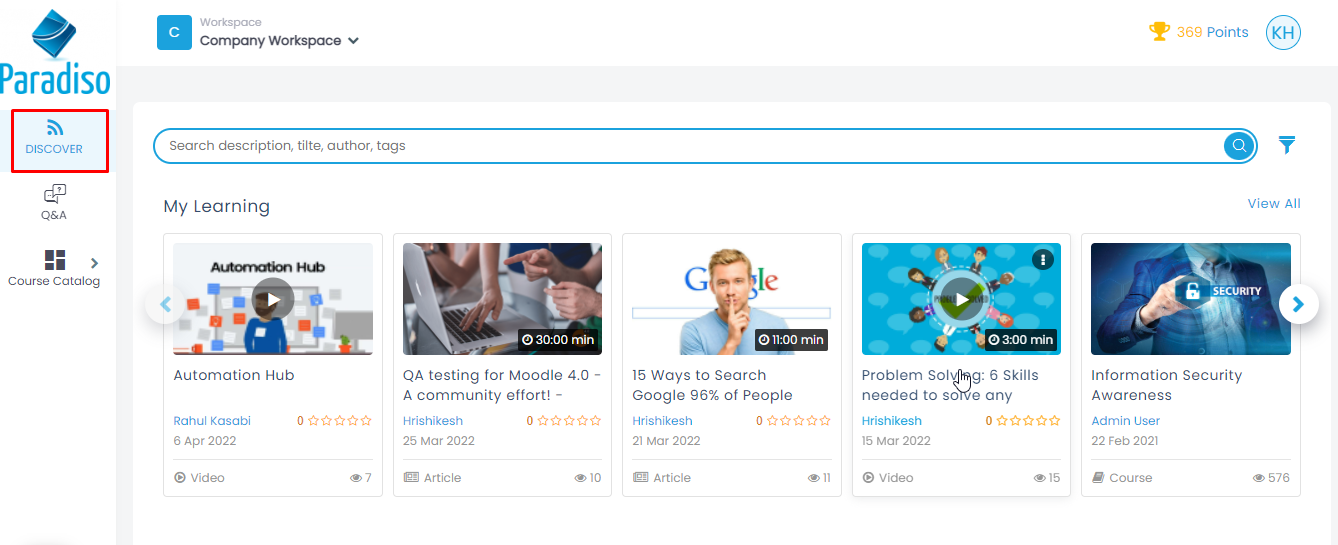
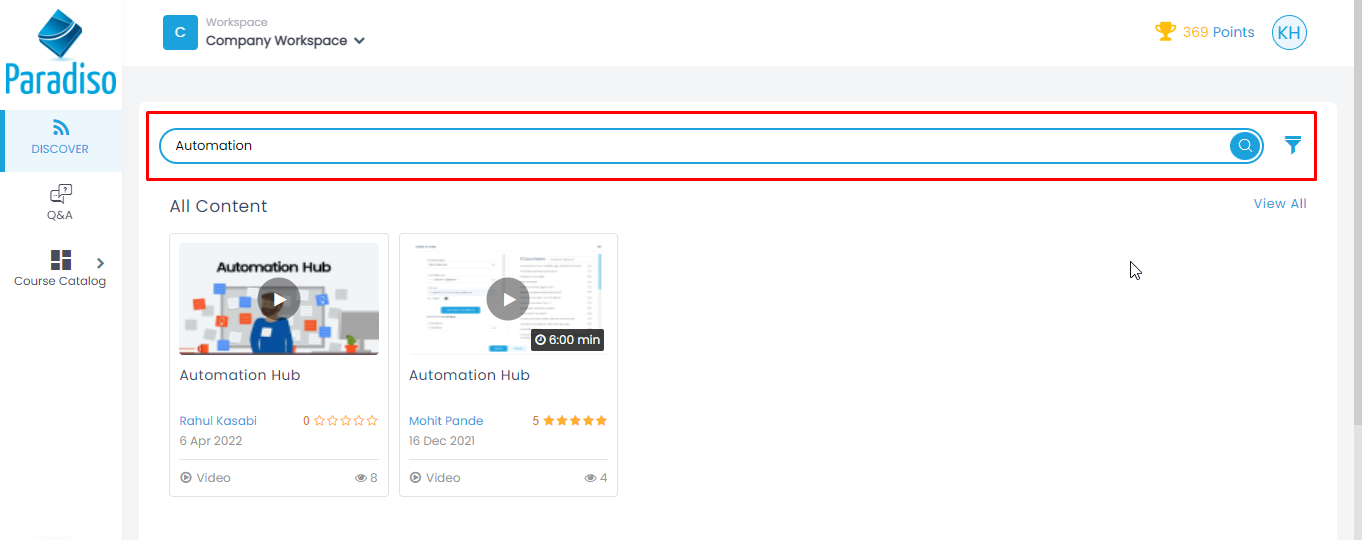
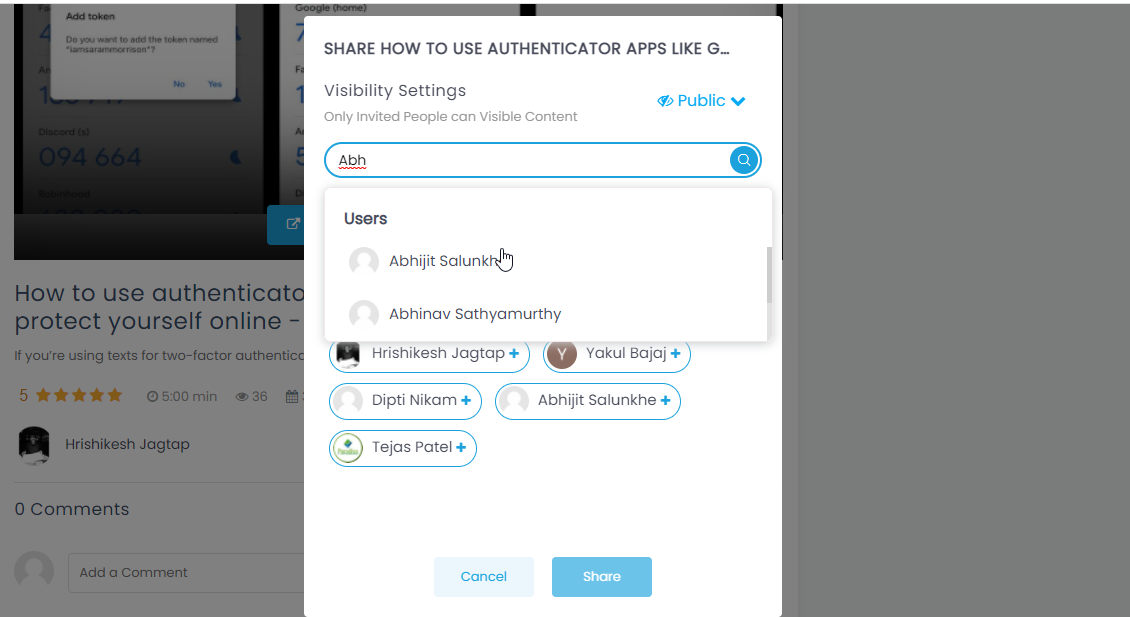
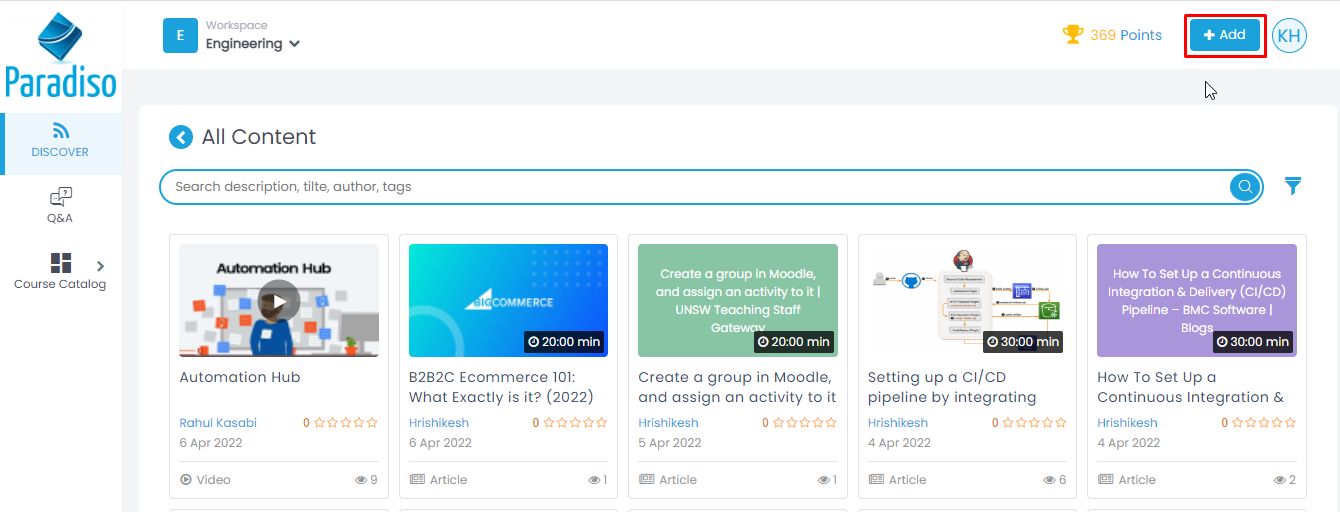
Add different type of content like video, documents, page etc.
